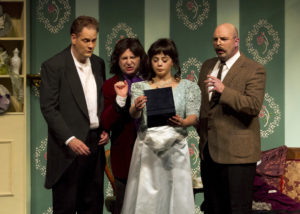Sherlock Holmes and the Case of the Jersey Lily : From stodgy to frothy in two acts

Sherlock Holmes and the Case of the Jersey Lily by Katie Forgette Directed by Val Bogan. An OLT production
It is not surprising that some of the dialogue in Sherlock Holmes and the Case of the Jersey Lily sounds familiar. Playwright Katie Forgette’s tongue-in-cheek look at Arthur Conan Doyle’s famous detective frequently borrows snippets from plays by William Shakespeare and Oscar Wilde as the mystery unfolds. These excerpts and such in-jokes as the working and final titles of Wilde’s most famous play provide some of the script’s most amusing moments.
Forgette also mixes and matches the fictitious Holmes, his sidekick Dr. Watson and his nemesis Professor Moriarty with real-life characters, Oscar Wilde, actress Lillie Langtry (the Jersey Lily of the title, after her birthplace) and even Queen Victoria’s assistant, Abdul Karim, winding fact and scandal into her wordy tale of Holmes as Langtry’s saviour. (Playwright Nicholas Meyer used a similar device in bringing Holmes and psychiatrist Sigmund Freud together in The Seven-Per-Cent Solution.)
Following the short opening sequence depicting a robbery, the audience meets Holmes and Watson chatting about Holmes’ most recent experiment and Watson’s wedding preparations. They sound bored with life. Boredom is a boring topic for listeners and, in the case of Forgette’s script, gives the wrong impression of the frothy piece that it will become in the second act.
As delivered by director Val Bogan and associate director Barbara Kobolak and their cast in the Ottawa Little Theatre production, the tone of the show moves gradually from stodgy through straightforward to light comedy and fun. But, in part because of the nature of the script and in part because of creaky set changes and lack of chemistry among some of the actors, it takes too long to become really entertaining.
This is in spite of some excellent performances. Riley Stewart, flamboyant, foppish and brightly costumed, has great fun with his lively portrayal of Oscar Wilde. Douglas Cuff, though sometimes difficult to understand, is quite effective as the cerebral detective and is ably backed with a believable characterization from Seamus O’Brien as Dr. Watson.
Lindsay Laviolette, while delivering a well-rounded performance, is faced with a challenge from the script. On more than one occasion, Wilde and Holmes tell her that she is too old to play the young heroine in The Importance of Being Earnest, when she actually looks perfect for the part.
Similarly, Ian Gillies and Ryan VanBuskirk, while performing their roles as required, simply look too young to be Moriarty and even the secondary villain, John Smythe. Holmes and Moriarty, as longtime adversaries, would be more convincing if they were in the same age range.
If the pace were faster and the tone closer to farce from the beginning, the casting balance would matter less. As presented, the contrasting ambience between the two acts and the early realism make it difficult to accept.
On the other hand, it is clear that a great deal of attention has been paid to costume design, and David Magladry’s sets, while cumbersome, are interesting and evocative of late-19th Century London.
The OLT production of Sherlock Holmes and the Case of the Jersey Lily continues to May 19.
Director……………………………………………………….Val Bogan
Associate director……………………………………………..Barbara Kobolak
Set and lighting……………………………………………….David Magladry
Sound…………………………………………………………Robert Krukowski
Costumes……….Glynis Ellens, Rachel Hauraney, Rebecca Morris, Donna Soussana
Cast:
Lillie Langtry…………………………………………………Lindsay Laviolette
John Smythe…………………………………………………..Ryan VanBuskirk
Sherlock Holmes………………………………………………Douglas Cuff
Dr. John Watson……………………………………………….Seamus O’Brien
Mrs. Glynn/Mrs. Tory/Kitty Dupree………………………….Ellen Manchee
Oscar Wilde……………………………………………………Riley Stewart
Abdul Karim…………………………………………………..Elliott Stewart
Professor Moriarty…………………………………………….Ian Gillies